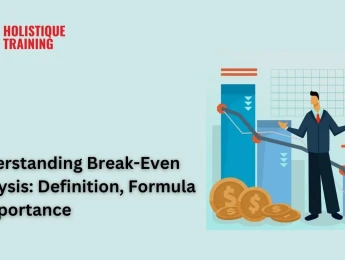- Table of Contents
- Introduction
- What is Break-Even Analysis?
- Components of Break-Even Analysis
- Standard Break-Even Time Period
- What is the Break-Even Point Formula?
- Calculating Contribution Margin and BEPs
- Who Calculates BEPs?
- 1. Finance and Accounting Departments
- 2. Business Analysts
- 3. Entrepreneurs and Managers
- 4. Financial Advisors
- 5. Sales and Marketing Teams
- 6. Operations Managers
- When to Use a Break-Even Analysis
- 1. Pricing Decisions
- 2. Investment Analysis
- 3. Cost Control
- 4. Forecasting
- 5. Financial Planning
- 6. Product Lifecycle Management
- 7. Evaluating New Business Ventures
- 8. Scenario Planning
- 9. Post-Launch Evaluation
- The Importance of Break-Even Analysis
- 1. Financial Viability Assessment
- 2. Informed Pricing Strategies
- 3. Resource Allocation and Planning
- 4. Risk Management
- 5. Performance Measurement
- 6. Strategic Decision-Making
- 7. Understanding Cost Structures
- 8. Scenario Analysis and Planning
- 9. Enhancing Communication with Stakeholders
- 10. Facilitating Performance Incentives
- Limitations of Break-Even Analysis
- 1. Assumptions of Constant Variables
- 2. Limited Scope of Analysis
- 3. Static Nature of Analysis
- 4. Ignores Time Value of Money
- 5. Neglects Market Demand and Competition
- 6. Overemphasis on Quantitative Factors
- 7. Does Not Address Fixed Costs Over Time
- 8. Challenges in Determining Variable Costs
- 9. Potential for Misinterpretation
- 10. Does Not Measure Profitability Beyond Break-Even Point
- Break-Even Analysis Examples
- Example 1: A New Product Launch
- Example 2: A Service-Based Business
- Conclusion
Introduction
Understanding financial performance is crucial for any business. Break-even analysis is one of the most fundamental tools for assessing a company's profitability. This method helps entrepreneurs, managers, and investors determine the minimum sales required to cover costs, providing a clear picture of financial health. This blog post delves into the intricacies of break-even analysis, its components, calculations, and applications, offering valuable insights for anyone looking to make informed financial decisions.
What is Break-Even Analysis?
Break-even analysis is a financial assessment that identifies the point at which total revenues equal total costs. At this juncture, a business neither makes a profit nor incurs a loss. This critical threshold is essential for pricing, production levels, and financial forecasting decision-making.
Components of Break-Even Analysis
- Fixed Costs are expenses that do not change with the level of production or sales volume, such as rent, salaries, and insurance. They remain constant regardless of how much is produced or sold.
- Variable Costs: Unlike fixed costs, variable costs fluctuate with production volume. These include materials, labour, and any other costs directly associated with manufacturing a product or delivering a service.
- Sales Price per Unit: This is the amount charged to customers for each unit sold. Understanding the pricing strategy is essential to determining profitability.
- Sales Volume refers to the number of units sold over a specific period, directly impacting revenue.
Components of a Break-Even Analysis |
Fixed costs |
Variable costs |
Sales Price per Unit |
Sales Volume |
Standard Break-Even Time Period
The break-even time period can vary depending on the business's nature and operational cycle. While some businesses assess break-even monthly or quarterly, others choose to evaluate it annually. The key is to align the break-even analysis with the company’s financial reporting cycles and strategic objectives.
What is the Break-Even Point Formula?
To perform a break-even analysis, one must calculate the break-even point (BEP), which indicates how many units of a product need to be sold to cover all costs. The formula for the break-even point in units is:
Break Even Point (BEP)=Total Fixed CostsSales Price per Unit - Variable Cost per Unit
This formula is essential for determining the minimum sales necessary to avoid losses. The denominator, often called the contribution margin per unit, reflects how much each unit sold contributes to covering fixed costs and generating profit.
Calculating Contribution Margin and BEPs
The contribution margin, defined as the difference between sales revenue and variable costs, is a vital component of break-even analysis. This metric informs business owners about how much money is available to cover fixed costs after covering variable expenses.
The contribution margin can be calculated using the following formula:
Contribution Margin = Sales Price per Unit - Variable Cost per Unit
Once the contribution margin is determined, calculating the break-even point becomes straightforward. For example, if the sales price of a product is $100, the variable cost is $60, and fixed costs total $20,000, the contribution margin is $40. Thus, the break-even point would be:
BEP=20,00040=500 units
This means the company must sell 500 units to break even.
Who Calculates BEPs?
Break-even points can be calculated by various individuals or teams within a business, depending on the organisation’s structure and size. Key players include:
1. Finance and Accounting Departments
In many organisations, the finance and accounting departments are primarily responsible for conducting break-even analysis. These teams comprehensively understand the company’s financial structure, including costs and revenue streams. They utilise financial data to ensure that calculations align with accounting principles and industry standards. By regularly performing break-even analysis, these departments help management understand financial thresholds, which is critical for budget planning, forecasting, and strategic decision-making.
2. Business Analysts
Business analysts often play a crucial role in evaluating a company’s financial health. They analyse data trends, market conditions, and internal metrics for strategic decisions. In the context of break-even analysis, business analysts may develop detailed reports that calculate the BEP and assess the implications of various scenarios, such as changes in pricing, cost structures, or sales volume. Their insights help the organisation make data-driven decisions about product launches, marketing strategies, and operational adjustments.
3. Entrepreneurs and Managers
Entrepreneurs and managers frequently calculate break-even points themselves for small businesses and startups. Understanding the BEP is vital for these individuals as it directly impacts pricing strategies, production levels, and cash flow management. By mastering break-even analysis, entrepreneurs can assess the viability of new ventures, make informed decisions on scaling operations, and set realistic financial goals. Their intimate business knowledge allows them to adapt the analysis to their unique challenges.
4. Financial Advisors
External financial consultants or advisors can assist in developing comprehensive financial models, including break-even analysis. These professionals bring experience and expertise from working with diverse businesses and industries. They help organisations understand their financial landscape by performing in-depth analyses and offering strategic recommendations based on break-even calculations. Collaborating with financial advisors can enhance a company's financial planning efforts, ensuring that decisions are grounded in sound analysis and best practices.
5. Sales and Marketing Teams
While not directly responsible for calculating BEPs, sales and marketing teams can greatly influence the underlying factors of the analysis, such as pricing strategies and sales forecasts. These teams must understand the break-even point to align their strategies with the company’s financial goals. For instance, if a sales team knows the BEP for a product, they can better strategise promotional campaigns, set sales targets, and understand how their efforts contribute to overall profitability. Additionally, marketing professionals can tailor their campaigns based on the analysis to attract customers and drive sales more effectively.
6. Operations Managers
In manufacturing or service industries, operations managers often engage with break-even analysis to optimise production processes and resource allocation. By understanding the BEP, they can determine the most efficient levels of production that meet demand while minimising costs. Operations managers can also collaborate with finance teams to identify cost-saving opportunities and enhance operational efficiency. This alignment ensures the organisation operates within its financial constraints while meeting customer demand.
In short, calculating break-even points is a collaborative effort that involves multiple stakeholders within an organisation. Each group brings its expertise to the table, contributing to a comprehensive understanding of the financial implications of business decisions. By working together, these teams can create a robust financial strategy that identifies the break-even point and supports the organisation’s long-term growth and sustainability. Whether through detailed analyses, strategic recommendations, or operational adjustments, the collective efforts of these individuals ensure that businesses can navigate their financial landscape effectively.
When to Use a Break-Even Analysis
Break-even analysis is a versatile tool applicable in various situations throughout the business lifecycle. Understanding when to use this analysis can significantly enhance strategic decision-making and financial management. Here are some key scenarios where break-even analysis proves especially valuable:
1. Pricing Decisions
When launching a new product or service, businesses must set prices that cover costs while remaining competitive. Break-even analysis provides insights into the minimum price necessary to avoid losses. By calculating the break-even point, businesses can evaluate how different pricing strategies will impact profitability. For instance, if a company considers a promotional price, break-even analysis helps determine how many units must be sold at that price to cover costs. This insight allows businesses to balance profitability with market competitiveness effectively.
2. Investment Analysis
Potential investors often conduct break-even analysis to assess a company's financial viability before committing capital. By understanding the break-even point, investors can gauge the level of risk associated with their investment. A lower break-even point suggests a quicker path to profitability, making the business more attractive to investors. Additionally, break-even analysis can highlight the financial sustainability of a project or product line, enabling investors to make informed decisions based on data rather than assumptions.
3. Cost Control
Regularly performing break-even analysis helps businesses identify areas where costs can be reduced without impacting revenue. Organisations can make informed decisions about where to cut expenses by examining fixed and variable costs. For instance, if a company discovers that its break-even point is too high due to excessive fixed costs, it may consider renegotiating contracts, outsourcing certain functions, or implementing more efficient processes. This proactive approach to cost management can enhance profitability and operational efficiency.
4. Forecasting
Businesses often use break-even analysis as part of their financial forecasting process. By projecting future sales and costs, companies can estimate when they will reach profitability. This information is crucial for strategic planning, helping organisations allocate resources effectively and anticipate financial needs. For example, a startup can use break-even analysis to estimate how long it will take to become profitable based on projected sales volumes, helping founders make informed decisions about funding, staffing, and operational scaling.
5. Financial Planning
Break-even analysis is an essential component of budgeting and financial planning. By understanding the minimum sales required to cover costs, businesses can develop realistic budgets that align with their financial goals. This analysis helps set sales targets, estimate cash flow needs, and plan for future investments. By integrating break-even analysis into their financial planning process, organisations can create a more resilient financial strategy that accommodates potential market fluctuations.
6. Product Lifecycle Management
Break-even analysis can inform various strategic decisions throughout the product lifecycle—from introduction to decline. In the introduction phase, businesses may need to invest significantly in marketing and production to establish their product in the market. Conducting a break-even analysis helps gauge how much of that investment is necessary to reach profitability. As the product matures, businesses can assess whether to adjust pricing or explore cost-saving measures to maintain profitability. During the decline phase, break-even analysis can guide decisions on whether to discontinue a product or reduce costs to prolong its life cycle.
7. Evaluating New Business Ventures
For entrepreneurs contemplating a new business venture, break-even analysis is vital for assessing potential profitability. It helps determine the feasibility of the business model and outlines the necessary sales volume to achieve financial sustainability. By calculating the BEP for a new product or service, entrepreneurs can identify financial requirements and develop strategies to meet those targets. This analysis also allows for scenario planning, helping entrepreneurs visualise how pricing, costs, or market conditions could impact their break-even point.
8. Scenario Planning
Break-even analysis enables businesses to plan scenarios by examining various "what-if" situations. For example, a company may want to assess how an increase in fixed costs—such as rent or salaries—will affect its break-even point. Alternatively, businesses can analyse the implications of changing variable costs, like raw material prices. By evaluating different scenarios, organisations can better prepare for uncertainties and adjust their strategies proactively to maintain profitability.
9. Post-Launch Evaluation
After launching a new product or service, businesses can use break-even analysis to evaluate its performance. By comparing actual sales against the break-even point, companies can assess whether they are on track to achieve profitability. If sales are consistently below the break-even point, businesses can investigate underlying issues—pricing, marketing effectiveness, or production costs—and make necessary adjustments. This ongoing evaluation process is crucial for sustaining growth and adapting to changing market conditions.
Break-even analysis is a powerful tool that can be applied in numerous contexts. It helps businesses make informed decisions about pricing, investments, and resource allocation. By understanding when to use this analysis, organisations can enhance their financial management practices, improve profitability, and navigate the complexities of the market landscape with greater confidence. Whether evaluating new ventures, managing existing products, or conducting financial forecasts, the insights gained from break-even analysis are invaluable for long-term success.
The Importance of Break-Even Analysis
Break-even analysis is important in business operations, strategy formulation, and financial planning. Providing critical insights into cost structures and sales dynamics enables businesses to make informed decisions that enhance profitability and sustainability. Here’s an in-depth exploration of the key reasons why break-even analysis is essential:
1. Financial Viability Assessment
One of the primary purposes of break-even analysis is to assess the financial viability of a product, service, or business model. Organisations can identify the minimum sales volume required to cover costs by determining the break-even point. This insight is crucial for entrepreneurs and businesses considering new ventures, as it helps gauge whether a project is feasible before significant investments are made. Understanding the break-even point aids in determining if projected sales are sufficient to justify the associated costs and risks.
2. Informed Pricing Strategies
Effective pricing strategies are vital for maintaining competitiveness while ensuring profitability. Break-even analysis helps businesses establish minimum pricing based on costs, guiding decisions on price adjustments, discounts, or promotional offers. By understanding how price changes impact the break-even point, businesses can make strategic pricing decisions that align with market conditions and consumer expectations. This insight is particularly beneficial during product launches or promotional campaigns, where the goal is to attract customers without jeopardising profitability.
3. Resource Allocation and Planning
As cited by Saviom, a McKinsey survey revealed that 83% of business leaders view effective resource allocation as a vital tool for driving growth. Break-even analysis serves as a foundation for effective resource allocation and financial planning. By understanding the break-even point, businesses can allocate resources—such as budget, staff, and inventory—more effectively. For instance, if a product has a high break-even point, a company may choose to limit production until sales volumes justify the investment. Also, break-even analysis supports budgeting processes by providing realistic sales targets that align with financial goals and optimises resources.
4. Risk Management
Understanding financial risks in an unpredictable market environment is crucial for business sustainability. Break-even analysis allows businesses to evaluate how fluctuations in costs or sales volumes affect profitability. For example, if raw material prices rise, the analysis can highlight the potential impact on the break-even point, prompting businesses to develop contingency plans, such as finding alternative suppliers or adjusting pricing strategies. Organisations can implement proactive measures to mitigate potential losses and maintain stability by assessing financial risks through break-even analysis.
5. Performance Measurement
Break-even analysis serves as a performance measurement tool, allowing businesses to track their progress toward profitability. By comparing actual sales against the break-even point, companies can assess whether they are on target to achieve their financial goals. This continuous monitoring helps identify trends, such as declining sales or increasing costs, enabling timely interventions to address issues before they escalate. By measuring performance through break-even analysis, organisations can foster a culture of accountability and continuous improvement.
6. Strategic Decision-Making
Strategic decision-making is a complex process that requires careful consideration of various factors. Break-even analysis provides valuable insights that inform strategic choices, such as product launches, market expansion, or cost-cutting measures. For instance, if a business is considering entering a new market, break-even analysis can help assess the feasibility of the expansion based on projected sales and costs. By grounding strategic decisions in data-driven insights, businesses can enhance their chances of success and long-term sustainability.
7. Understanding Cost Structures
A thorough understanding of cost structures is essential for effective business management. Break-even analysis helps organisations categorise costs into fixed and variable components, clarifying how these costs influence profitability. By analysing these cost structures, businesses can identify opportunities for cost reduction, such as renegotiating supplier contracts or optimising production processes. This knowledge enables organisations to make informed decisions about scaling operations, launching new products, or managing existing services.
8. Scenario Analysis and Planning
Break-even analysis allows businesses to conduct scenario analyses, evaluating the potential impact of various changes on profitability. For instance, businesses can simulate the effects of increased marketing expenses, changes in production methods, or fluctuations in sales volume. This capability helps organisations prepare for uncertainties and develop adaptive strategies that respond to evolving market conditions. By considering multiple scenarios through break-even analysis, businesses can enhance their resilience and agility in facing challenges.
9. Enhancing Communication with Stakeholders
Break-even analysis is a powerful communication tool that effectively conveys financial health and operational goals to stakeholders, including investors, management, and employees. Presenting break-even data clearly and concisely helps stakeholders understand the financial implications of strategic decisions, fostering transparency and trust. Additionally, having a shared understanding of the break-even point can align team efforts toward common objectives, creating a cohesive approach to achieving profitability and growth.
10. Facilitating Performance Incentives
In organisations where performance incentives are tied to financial metrics, break-even analysis can help establish benchmarks for employee performance. By setting sales targets aligning with the break-even point, businesses can motivate employees to focus on profitability. This alignment fosters a results-oriented culture and ensures that all team members understand the importance of contributing to the organisation’s financial success.
The significance of break-even analysis in business operations must be considered. By providing insights into financial viability, pricing strategies, resource allocation, and risk management, break-even analysis empowers organisations to make informed decisions that drive profitability and sustainability. As businesses navigate an increasingly complex marketplace, leveraging the power of break-even analysis will remain a critical component of effective financial management and strategic planning. Organisations can enhance their agility, resilience, and overall success by embedding this analysis into their operations.
Limitations of Break-Even Analysis
While break-even analysis is a valuable tool for understanding financial dynamics and guiding business decisions, it is essential to recognise its limitations. These constraints can impact the accuracy and applicability of the analysis, leading to potential pitfalls if not carefully considered. Here are the key limitations of break-even analysis:
1. Assumptions of Constant Variables
Break-even analysis is based on several assumptions that may not hold true in real-world scenarios. The most critical assumption is that both fixed and variable costs remain constant over the analysis period. However, in practice, costs can fluctuate due to various factors, including changes in supplier pricing, labour costs, and economies of scale. For instance, as production increases, companies may benefit from bulk purchasing discounts, which can lower variable costs. If costs change, the calculated break-even point may no longer be accurate, leading to misguided decisions.
2. Limited Scope of Analysis
Break-even analysis typically focuses on a single product or service at a time, which may not reflect the complexities of a multi-product business. In scenarios where multiple products share resources or have interdependent sales, the break-even point for one product may affect the others. For example, if one product is heavily subsidised to drive sales, it may impact the profitability of other products' profitability. This limitation makes applying break-even analysis effectively in diversified businesses challenging without a more comprehensive approach.
3. Static Nature of Analysis
Break-even analysis often provides a snapshot in time, offering insights based on current costs and sales volumes. However, businesses operate in dynamic environments where market conditions, consumer preferences, and competitive landscapes continuously evolve. A static analysis may not adequately capture these changes, leading to outdated conclusions. For instance, a currently profitable product may become unviable due to shifts in consumer demand or the entry of competitors. Regular updates and ongoing assessments are necessary to maintain the relevance of break-even analysis.
4. Ignores Time Value of Money
Break-even analysis typically does not account for the time value of money, which is a crucial consideration in financial decision-making. The time value of money concept asserts that a dollar today is worth more than a dollar in the future due to its potential earning capacity. This limitation means that break-even analysis may overlook the financial implications of delayed sales or investments, affecting a project’s viability assessment. Without incorporating the time value of money, businesses may misjudge the financial feasibility of long-term projects.
5. Neglects Market Demand and Competition
While break-even analysis focuses on costs and sales volume, it often overlooks broader market factors, including demand and competition. A business may calculate a break-even point based on existing costs. Still, if the market demand for the product decreases or if competitors introduce similar products at lower prices, the calculated break-even point may become irrelevant. Ignoring these external factors can lead to overconfidence in achieving profitability, resulting in financial losses if market conditions shift unexpectedly.
6. Overemphasis on Quantitative Factors
Break-even analysis primarily focuses on quantitative data, such as costs and sales volumes, potentially neglecting qualitative factors influencing business success. Customer satisfaction, brand reputation, and employee morale are crucial for long-term sustainability but may not be adequately represented in a break-even analysis. Relying solely on numerical data can lead businesses to overlook important qualitative aspects of overall performance and profitability.
7. Does Not Address Fixed Costs Over Time
The analysis assumes that fixed costs, such as rent and salaries, remain constant during the analysis period. However, as businesses grow or contract, fixed costs can change. For example, a company may need to invest in additional facilities or staff to accommodate increased production. The break-even analysis can yield misleading results if these fixed costs are not accurately projected. Understanding how fixed costs evolve over time is essential for a more accurate profitability assessment.
8. Challenges in Determining Variable Costs
Identifying and calculating variable costs can be challenging, especially in complex operations where costs are not easily categorised. For instance, certain costs may appear fixed but can vary based on production levels or operational changes. Inaccurate classification of costs can lead to erroneous break-even point calculations, resulting in flawed decision-making. Therefore, businesses must ensure accurate cost allocation to derive meaningful insights from break-even analysis.
9. Potential for Misinterpretation
Break-even analysis is often presented in a simplified format, which may lead to misinterpretation by stakeholders. Individuals who are not well-versed in financial analysis might misunderstand the implications of the break-even point or fail to grasp the underlying assumptions. This misinterpretation can result in decisions based on incomplete or incorrect information, potentially harming the organisation’s financial health.
10. Does Not Measure Profitability Beyond Break-Even Point
While break-even analysis identifies the sales volume required to cover costs, it does not provide insights into profitability beyond that point. Once a business surpasses its break-even point, understanding how different sales levels affect profitability becomes essential. Businesses need to conduct further analysis to determine profit margins, understand how pricing strategies impact profitability, and identify the sales levels required to achieve specific profit targets.
In summary, despite its numerous advantages, break-even analysis has several limitations that businesses must consider when using this tool for decision-making. By recognising these constraints, organisations can mitigate risks associated with overreliance on break-even analysis and adopt a more comprehensive approach to financial planning and strategy development. Combining break-even analysis with other financial metrics and qualitative assessments can provide a more holistic view of business performance, enabling informed decisions that drive long-term success.
Break-Even Analysis Examples
To illustrate the application of break-even analysis, consider the following hypothetical scenarios:
Example 1: A New Product Launch
Imagine a company planning to launch a new gadget. The fixed costs associated with the launch total $50,000, including marketing, research and development, and overhead. The variable cost per unit is $30, while the sales price is set at $70.
- Calculate Contribution Margin:
Contribution Margin = 70 - 30=40 - Calculate BEP:
BEP=50,00040=1,250 units
This analysis reveals that the company must sell 1,250 units to break even, informing its production and marketing strategies.
Example 2: A Service-Based Business
Consider a consulting firm with fixed costs of $20,000 and variable costs of $100 per client engagement. If the firm charges $500 per engagement, the calculations would be:
- Calculate Contribution Margin:
Contribution Margin = 500-100=400 - Calculate BEP:
BEP=20,000400=50 clients
The consulting firm needs to secure 50 clients to cover its costs, which will allow it to evaluate its client acquisition strategies effectively.
Conclusion
Break-even analysis is an indispensable tool for businesses navigating their financial landscape. By understanding this analysis's components, calculations, and implications, entrepreneurs and managers can make informed decisions that align with their strategic goals. While the analysis has limitations, its insights into pricing, cost control, and profitability planning make it a crucial financial management component. As businesses evolve in an ever-changing economic environment, mastering break-even analysis will empower them to achieve sustainable growth and financial success.
Consider enrolling in our Business Financial Planning & Control course to enhance your financial acumen further. This comprehensive program will provide you with the skills and knowledge necessary to implement effective financial strategies, including advanced techniques in break-even analysis and beyond.

























